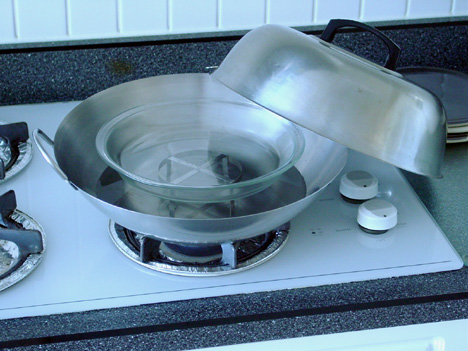Steam has been used in China for cooking for thousands of years. Today, steaming remains an integral aspect of many Chinese and Asian kitchens. Compared to grilling and roasting, which requires a very hot sustained source of heat, steam calls for a less rigorous fire. The principle behind steaming is simple: When water reaches its boiling point of 212F, steam-the gaseous state of water-is produced. Trapped in a covered receptacle, the hot moist vapor rises upwards and produces a wet oven-like environment for food to cook in.
The benefits of steaming are numerous. Its basic preparation, minimal equipment and easy clean up make it an appealing way to cook for everyone. Once seasoned, vegetables, meats, fish and poultry are ready to eat right out of the steamer. Steaming maintains the integrity of flavor in foods. Poultry and meats that are traditionally boiled, roasted or braised have more flavors when steamed and don’t run the risk of drying out. A far higher level of nutrients, vitamins and minerals is retained than by other cooking methods. Steam cooking reduces Vitamin C in vegetables by 40% whereas boiling reduces it by 70% because it is lost in the cooking water. Steaming is also an excellent method for re-heating food without scorching it. Though steaming won’t achieve a deeply browned and caramelized finish on the exterior of food like dry heat does, it will produce a moist and deeply flavored dish. If you want to brown something, you can cook it twice by roasting or quick frying after it has been steamed.
Steaming requires very little equipment. The three essential components are a pot or wok of water, a rack, steamer basket, or dish to hold the food and a lid to keep the steam from escaping. A three-tier Chinese aluminum or bamboo steamer is the perfect tool, able to cook several dishes at once.


Steaming Tips:
- Steam needs to circulate freely so food must be arranged spaciously. Keep foods uniform in size to facilitate even cooking.
- Always steam in a plate deep enough to catch cooking juices. A 7- to 9-inch plate with curved, sloped sides (2 inches deep) is perfect. Wide-flared pasta or pie dishes will do the job.
- Do not allow the water generating the steam touch the food, or the food will boil and not steam. Suspend it at least 1 inch (2.5 cm) above the water. There should be enough water in the bottom throughout the steaming process. Top it off with boiling water when steaming for long periods to produce a constant supply of steam.
- Use the freshest vegetables and meats, especially seafood. Steam cooking exposes the best of fresh ingredients, and the worst of poor ingredients.
- When using steamer equipment, consult a manufacturer’s guide for cooking times, but adhere to basic cooking principles for each food. Check for doneness by looking for appropriate texture, color, consistency, shape and aroma. Continue to cook foods that are not cooked through or not cooked to your liking, despite having been cooked for the recommended cooking time. Steamed foods should be plump, moist and tender. Flesh of fish and shellfish will lose translucency and become opaque. Mollusks, such as clams and mussels, open when properly cooked. Vegetables will have good color and no graying. Grains will be fluffy and tender.
- Practice kitchen safety: Remember that steam is extremely hot. Protect hands and face when raising a lid or cover.
- Modify heat according to the nature of food being steamed. An intense or rolling boil can cook too fast, causing some delicate proteins such as fish fillets to contract.
- If steaming is used as a preliminary cooking technique, heat only until food reaches a par-cooked state. Remove immediately and plunge into cold water to stop cooking.
- Always defrost frozen meats, fish and poultry before cooking, to allow for correct and complete cooking within the recommended times.

No comments:
Post a Comment